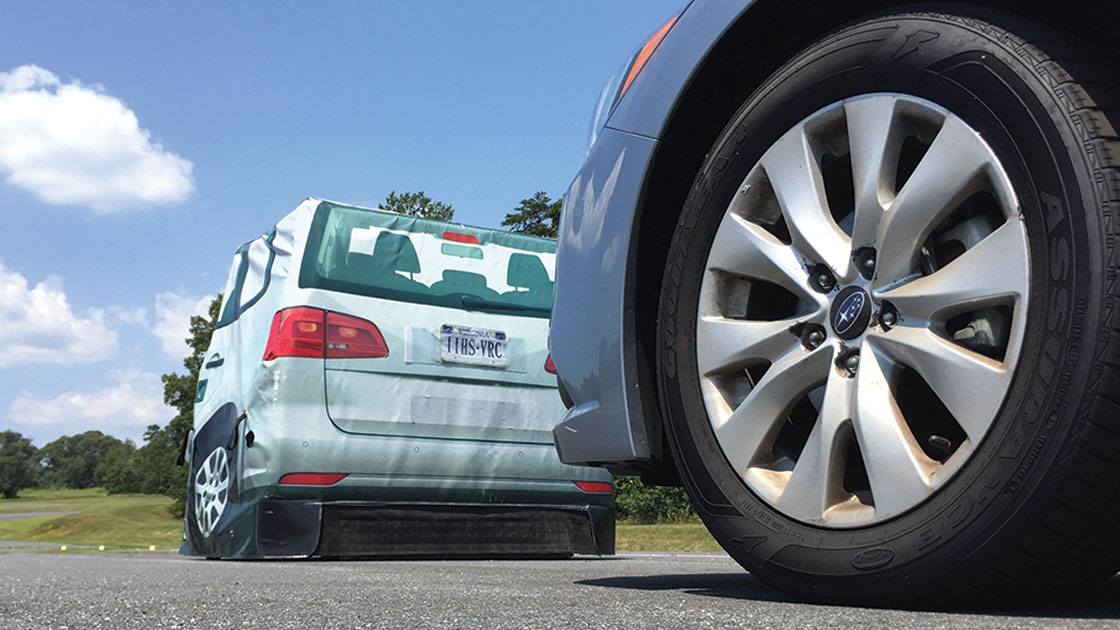Evidence continues to mount in favor of front crash prevention
August 26, 2015

Insurance data for vehicles with front crash prevention continue to pile up, making the trends ever more clear. Vehicles equipped with these systems consistently show lower rates of claims for damage to other vehicles and for injuries to people in other vehicles.
The latest reports from HLDI on front crash prevention also document reductions in damage to equipped vehicles and injuries to their occupants. However, those benefits vary among the systems from Honda, Volvo and Subaru, though it's not clear why.
HLDI first reported on reductions in claim rates for Volvo's low-speed autobrake system, City Safety, in 2011 and began noting benefits for higher-speed systems in 2012.
As more and more vehicles on the road are equipped with the systems — some of which warn of impending crashes, some of which brake automatically, and some of which do both — patterns have emerged more clearly. In total, HLDI has studied nine different front crash prevention systems from five manufacturers.
"The specific benefits vary somewhat by system, but our latest analyses all show large reductions in property damage and bodily injury liability claim rates," says HLDI Vice President Matt Moore.
Property damage liability coverage pays for damage to other vehicles, and bodily injury liability pays for injuries to people in other vehicles or other road users.
"Interestingly, the reductions in bodily injury claims are about twice the size of the property damage claim reductions," Moore adds. "A large number of bodily injury claims are for whiplash injuries that occur when your vehicle strikes another from behind. That's the main type of crash that current front crash prevention systems are designed to avoid."
Volvo City Safety
City Safety is meant to reduce the low-speed front-to-rear crashes that commonly occur in urban traffic. The earliest versions of the system operate at speeds up to 19 mph and rely on an infrared laser sensor built into the windshield. If it detects an impending crash, it automatically brakes the vehicle.
Percent differences in claim frequency for Volvos with City Safety, all values statistically significant
HLDI analysts previously studied the effect of standard City Safety on the Volvo XC60 by comparing that vehicle's claim rates with other midsize luxury SUVs. They also studied City Safety on the Volvo S60 by comparing it to other midsize luxury cars.
In the latest report, HLDI calculated combined results for both vehicles to come up with an overall effect for City Safety. They found that City Safety reduced claim frequency under all coverages 15-29 percent. All results were significant.
HLDI also took a separate look at how the City Safety benefit holds up as vehicles age. Comparing vehicles ranging from new to 5 years old, there was no pattern of diminished benefits over time.
Beginning with 2014 models, City Safety was changed to operate at speeds of up to about 30 mph. The new version isn't included in the HLDI studies.
Honda forward collision warning
The Honda Accord's optional forward collision warning system operates at speeds above 10 mph and comes paired with lane departure warning. HLDI first looked at these systems a year ago. These warning systems are standard equipment on some Accord trim levels and on the Honda Crosstour, an SUV built on the Accord platform.
The updated results are similar to last year's. Compared with Accords and Crosstours without the features, those with the features saw claim frequency reductions under all coverages. Only the reductions under property damage liability (12 percent), bodily injury liability (27 percent) and medical payment (22 percent) are statistically significant. Medical payment insurance covers injuries to occupants of the insured vehicle.
Percent differences in claim frequency for Hondas equipped with forward collision and lane departure warning features
Camera-based system: Accord/Crosstour
Radar-based system: Accord Touring; includes adaptive cruise control
The Accord's main forward collision warning system relies on a camera located inside the windshield. However, the Touring trim has a different system, one that uses radar to detect vehicles in front. In addition to forward collision and lane departure warning, this version of the feature also includes adaptive cruise control.
The radar-based system showed reductions in claim frequency for all coverages except collision and personal injury protection, which is sold in states with no-fault insurance systems and covers injuries to people in the insured vehicle. Only the results for property damage liability (16 percent) and bodily injury liability (39 percent) were statistically significant.
Not surprisingly, collision claim severity was much higher for vehicles with the radar-based system. The average cost per claim was $522 higher for equipped vehicles. That likely reflects the cost of repairing the radar system after crashes that weren't avoided. The radar units are located in the front grille and are therefore much more vulnerable to damage than cameras located inside the occupant compartment.
Subaru EyeSight
Subaru's optional, camera-based EyeSight system is one of the few front crash prevention systems to earn a perfect score in IIHS ratings. The system warns of impending crashes and, if the driver fails to stop, brakes automatically. The autobrake function completely avoids collisions in both the 12 mph and 25 mph IIHS tests. In addition to front crash prevention, EyeSight includes adaptive cruise control, lane departure warning and lead vehicle start alert, which notifies the driver if the vehicle remains stopped several seconds after a vehicle in front has moved.
For the model years in the study, EyeSight was available on the Forester, Legacy and Outback. HLDI found that when those models were equipped with the feature, property damage liability claim frequency was 15 percent lower and bodily injury liability frequency was 35 percent lower. Results under other coverages were mixed but not statistically significant.
Percent differences in claim frequency for Subarus with EyeSight